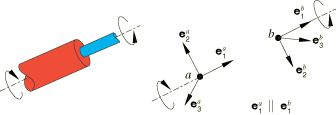REVOLUTE | |||||||||
|
| ||||||||
ProductsAbaqus/StandardAbaqus/ExplicitAbaqus/CAE
Description

A REVOLUTE connection constrains two rotational components of relative motion between two nodes and allows one free rotational component. The two kinematic constraints imposed by the REVOLUTE connection are
which are equivalent to the requirement that . Alternatively, the REVOLUTE constraint is equivalent to setting the second and third Cardan angles to zero in a CARDAN connection. If the shared axes and do not align initially, the REVOLUTE constraint will hold the second and third Cardan angles fixed at their initial values. The constraint moment in the REVOLUTE connection is
Node b can rotate about the shared local direction . The relative angular position of the local directions at node b relative to a is
where is the first Cardan angle measuring a counterclockwise rotation about the -direction of to .
The available component of relative motion, , measures the change in angular position and is defined as
where is the initial angular position and n is an integer accounting for multiple rotations about the shared axis. The connector constitutive rotation is
The kinetic moment in the REVOLUTE connection is
![]()
Friction
When used by itself, there is no predefined Coulomb-like friction in the REVOLUTE connection. However, when the REVOLUTE connection is used in combination with a JOIN, SLIDE-PLANE, or SLOT connection, the predefined friction is the same as the HINGE, PLANAR, and CYLINDRICAL connections, respectively.
![]()
Summary
| ||||||||||||||||||||||||